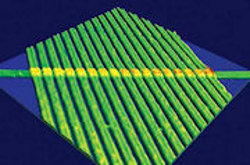Archive
Moore’s law gets a boost

Memristor
In 1965 Gordon Moore, the co-founder of Intel, suggested that the number of components in integrated circuits had doubled every year from the invention of the integrated circuit in 1958 until 1965 and predicted that the trend would continue “for at least ten years”. In 1970 Douglas Engelbart (co-inventor of the mechanical mouse) of Caltech coined the phrase “Moore’s Law”. In 1975, Moore altered his projection to a doubling every two years. There is a popular misconception, that he predicted a doubling “every 18 months”. However, which ever version of the Law you ascribe to, it has held up over the decades
The challenge has been that of physics, and the increasing difficulty of increasing the density of transistors on the integrated circuit. It seems that help may be on hand. In 1971 Prof Leon Chua, at Berkeley, suggested that having two separate devices in a computer, one to store data and one to process data did not make sense. He suggested memristors (transistors with memory), and that there was a conceptual symmetry between the resistor, inductor, and capacitor, and suggested that the memristor is a similarly fundamental device.
He compared this theoretical device to the synapses and axons in the human brain. With their use we can re-think the architecture of computers, allowing “brain-like computers” to be developed. Such computers would be more energy efficient, would be less computational wasteful and could replace today’s flash memory. Research by a team at the University of Michigan has already shown that they can store twice as much as an equivalent sized flash memory, and that they can be stacked to form three-dimensional arrays (theoretically in stacks of thousands of layers) . It is hoped that this memory device will be ready to come to the market in three years.
It is the longer-term future (6 to 10 years) for this device which is most exciting. Currently, processors have transistors which are as small as 22 nanometres. Memristors have been made as small as 3 nanometres. It is the memristors compatibility with existing transistor-based technologies which will allow rapid implementation using today’s materials and chip fabrication plants. This will allow Moore’s Law to continue for several decades to come. HP who are developing the technology believe it has the ability to “turn the computing world upside down”.
|
Please consider linking to this blog from your Facebook, your Twitter account, your website or your email signature. Please also feel free to tell people about it. Thank you. |
|---|

This is me